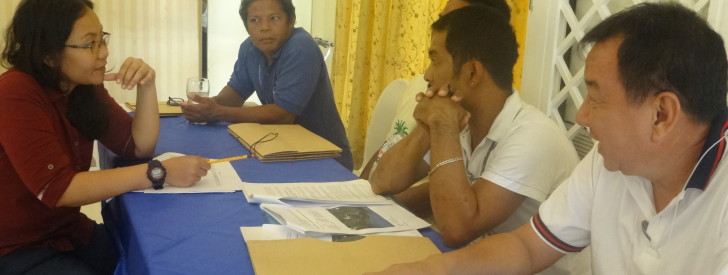 PRDP NPCO NRM Officer Ma. Shea C. Bitalac administers the MPA Evaluation of the Pilar Marine Fish Reserve & Sanctuary using the MEAT and METT.
PRDP NPCO NRM Officer Ma. Shea C. Bitalac administers the MPA Evaluation of the Pilar Marine Fish Reserve & Sanctuary using the MEAT and METT. DA-PRDP to help raise level of management effectiveness in Bicol’s marine protected areas
Implementation of management plans for marine protected areas (MPAs) along the Donsol-Ticao-Burias Pass in Sorsogon and Masbate provinces need reinforcement. This was the general observation of Natural Resource Management Specialist Ulysses Triambulo during the Policy Development Framework for Effective Coastal and Marine Ecosystems Management Assessment and Action Planning conducted by the Philippine Rural Development Project (PRDP) in Legazpi City on May 24 to 27, 2016.
Based from the result of the MPAs’ evaluation using the Management Effectiveness Assessment Tool (MEAT) and Management Effectiveness Tracking Tool (METT), MPA sites in Bicol belong to level 1 (established) and level 2 (strengthened). MEAT and METT are management tools used to measure, monitor and track MPA effectiveness and progress in terms of enforcement, implementation and maintenance.
“We need more support interventions to increase the MPAs’ management effectiveness,” Triambulo said.
According to the International Union for Conservation of Nature and Natural Resources (IUCN), management effectiveness refers to the degree to which actions attain a protected area’s goals and objectives. It has four levels namely 1. established, 2. strengthened, 3. sustained, and 4. institutionalized.
The MPA assessment and action planning was attended by the municipal agriculturist officers (MAOs), agricultural technicians, and representatives from people’s organizations in targeted program areas in Bicol namely Bulan, Pilar, Magallanes, and Matnog, Sorsogon and representatives from San Fernando, Masbate and the Provincial Project Management and Implementation Unit (PPMIU) of Sorsogon. Nonie P. Enolva of the Bureau of Fisheries and Aquatic Resources V and Ma. Rosa Vida C. Onrubia of the Department of Environment and Natural Resources V also supported the activity which was facilitated by DA PRDP Natural Resource Management Specialist Ulysses R. Triambulo, Ma. Shea C. Bitalac, Ferdinand Cruz and Bicol NRM Specialist Lorenzo L. Alvina.
The strengths and weaknesses of Bicol’s five MPA sites under the PRDP GEF were gauged based on threshold indicators and management focus categorized into management plan, site development, management body, enforcement, community participation, financing, monitoring and evaluation, legal instrument and information, education and communication. A workshop was also conducted to enable the participants to produce their Coastal Resources Use Zones Map.
“Planning is important so that you can put the right project in the right area,” Onrubia said.
Meanwhile, Enolva discussed common management issues in locally managed MPA and fish sanctuaries including lack of clear lines of decision making, lack of efficient fiscal management, and lack of political support. She also shared management strategies for implementation such as designating leaders who possess management skills, developing members’ entrepreneurial skills and reviewing the plan versus ground realities.
“The PRDP will help accelerate resource protection and management in the five pilot municipalities of Ticao Pass. MPA network is an entry to Marine Spatial Planning which is the focus of this activity on policy development. The prospect of PRDP as a catalyst in coastal community development is very high especially if coupled with natural resource management,” she said.
Triambulo, on the other hand, stressed the importance of a knowledgeable and vigilant management organization. He urged the participants to formulate policies and update existing MPA ordinances. A sample outline of a Marine Sanctuary Management Plan for them to adopt was also provided. Furthermore, he shared the best practices of MPA management bodies in Bohol where barangay officials are vigilant and strict in the implementation of policies.
Rafael M. Burton, Municipal Agricultural Officer of the Municipality of Magallanes said that the MPA assessment and action planning was very beneficial for it made them realize what needs to be improved in the Magallanes Fish Sanctuary and Marine Reserve’s management system.
According to Enolva, Ticao Pass is one of the country’s important Marine Key Biodiversity Areas (MKBAs) along with its neighboring fishing ground, Burias Pass.
“These fishing grounds are home to a rich assemblage of some megafauna in the country like the whale shark, manta ray, cetaceans and turtles. Fishes are also abundant in Ticao Pass due to its rich plankton production. Currently, there are more than 12,000 registered municipal fisherfolk in the area and about 65% of these are engaged in capture fishing and are considered as direct resource users. Degradation of the fishing ground could mean loss of livelihood resource for fishers who have very high dependence on these fisheries resources,” she added.
Targeted program areas in Bicol under GEF are encouraged to submit MPA and microenterprise sub-project proposals worth P5 million per site to support its objective of strengthening the conservation and protection of the coastal and marine resources through biodiversity conservation and fisheries resources management. GEF, an international organization that advocates environmental conservation and protection, provided a P287 million-worth grant to PRDP to support MPAs in area of global biodiversity significance.
An on-site re-validation of the Donsol-Ticao-Burias Pass MPAs’ MEAT and METT results will be conducted by PRDP-Bicol in June 2016. (Annielyn L. Baleza, DA-PRDP RPCO V InfoACE Unit)
